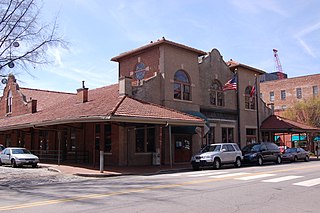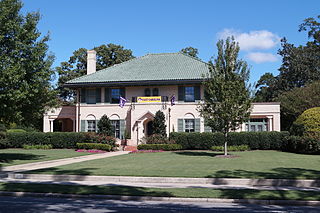
Wilmington is a port city and the county seat of New Hanover County in coastal southeastern North Carolina, United States.

Cameron A. Morrison was the 55th Governor of the U.S. state of North Carolina from 1921 to 1925.

The State Bank of North Carolina is the oldest surviving commercial building in Raleigh, North Carolina and was the first state-sponsored banking institution constructed in North Carolina. The bank was incorporated in 1810, but during the War of 1812 cash was moved inland to banks in Raleigh and Tarboro for fears that the British Army would attack the coast. The increase in money deposits resulted in the State Bank's construction in 1813. Jacob Johnson, the father of future President Andrew Johnson, was once employed at the bank. The building was listed on the National Register of Historic Places in 1970 and is a Raleigh Historic Landmark. It is located in the Capitol Area Historic District.

The Moore Square Historic District is a registered historic district located in downtown Raleigh, North Carolina. Listed on the National Register of Historic Places in 1983, the district is centered on Moore Square, one of two surviving four-acre parks from Raleigh's original 1792 plan. The park is named after Alfred Moore, a North Carolina judge who became an Associate Justice on the Supreme Court. Originally a residential neighborhood, Moore Square developed into a primary commercial hub in the city throughout the late 19th and early 20th centuries. The district includes East Hargett Street, once known as Raleigh's "Black Main Street", because it once contained the largest number of businesses owned by African-Americans in the city. City Market, Marbles Kids Museum/IMAX theatre, Pope House Museum, Artspace, and the Long View Center are located in the Moore Square district. Events that take place in Moore Square include the Raleigh Arts Festival, Artsplosure, Movies in the Park, the Street Painting Festival, and the Moore Square Farmer's Market The approximate district boundaries include Person, Morgan, Wilmington, and Davie Streets.

The United States Post Office and Courthouse is a courthouse of the United States District Court for the Eastern District of North Carolina, located in New Bern, North Carolina. The building was completed in 1935, and was listed in the National Register of Historic Places in 1973, as a contributing building within the New Bern Historic District, and was individually listed in 2018.

The Shepard Street–South Road Street Historic District is a national historic district located at Elizabeth City, Pasquotank County, North Carolina. The district encompasses 161 contributing buildings in a historically African-American section of Elizabeth City. The district developed from the mid-19th to mid-20th century, and includes representative examples of Greek Revival, Gothic Revival, Italianate, Queen Anne, Colonial Revival, Bungalow, and American Foursquare style architecture. Notable contributing buildings include the Sawyer–Pailin–Overman House, Antioch Presbyterian Church, (former) St. Catherine Catholic Church (1941), Olive Branch Missionary Baptist Church (1904), Corner Stone Missionary Baptist Church (1888), (former) St. Phillips Episcopal Church (1893), the Sundry Shop, Rex Cleaning Works (1932), Good Samaritan Hall (1896), and Republican Star Odd Fellows Hall.
Leslie N. Boney Sr. (1880–1964) was an American architect who focused on schools. He designed approximately 1,000 schools or additions to schools, and his works appear in 51 of North Carolina's 100 counties.

The College View Historic District is a national historic district located north of East Carolina University at Greenville, Pitt County, North Carolina. The district encompasses 343 contributing buildings in a predominantly residential section of Greenville. It includes buildings dated from about 1909 to World War II and notable examples of Bungalow / American Craftsman, Colonial Revival, and Tudor Revival architecture. Notable buildings include St. Paul's Episcopal Church (1930), the Rotary Club Building (1921), Chancellor's Residence, William Harrington House, Bateman House (1910), Franklin Vines Johnston House (1923), and Dr. Paul Fitzgerald House (1929).

Poplar Grove Plantation is a peanut plantation by the Topsail sound in Scotts Hill near Wilmington in Pender County, North Carolina. It was listed on the National Register of Historic Places listings in North Carolina on July 16, 1979.

North Main Street Historic District is a national historic district located at Mocksville, Davie County, North Carolina. The district encompasses 115 contributing buildings and 2 contributing sites in a linear residential section of Mocksville. It was developed between the 1840s and World War II and includes notable examples of Greek Revival, Italianate, Gothic Revival, Queen Anne, Classical Revival, Shingle Style, American Craftsman, Tudor Revival, and Colonial Revival style residential architecture. Also in the district are the First Methodist Church (1896), the Mocksville Graded School (1911), and the Masonic Picnic Grounds, established in 1883.

Fisher Park Historic District is a national historic district in the Fisher Park neighborhood, Greensboro, Guilford County, North Carolina. The district encompasses 541 contributing buildings, 2 contributing sites, and 44 contributing structures in a predominantly residential section of Greensboro. The houses were largely built between the 1900s and 1930s and include notable examples of Queen Anne, Colonial Revival, Gothic Revival, American Foursquare, and Bungalow / American Craftsman-style architecture. Located in the district are the separately listed Dixon-Leftwich-Murphy House, John Marion Galloway House, Julian Price House, and Latham-Baker House. Other notable buildings include the First Presbyterian Church (1928), Holy Trinity Episcopal Church (1922), Gant-McAlister House, and A.J. Schlosser House.

Carthage Historic District is a national historic district located at Carthage, Moore County, North Carolina. The district encompasses 85 contributing buildings, 1 contributing site, 5 contributing structures, and 1 contributing object in a predominantly residential section of Carthage. It was developed between the 1850s and 1940 and includes notable examples of Queen Anne, Greek Revival, and Colonial Revival style architecture. Notable buildings include the Carthage Methodist Church (1898-1900), (former) Carthage Community House (1939-1940) built by the National Youth Administration, the "Chub" Seawell House, Edgehill, Charles Sinclair House, Dr. John Shaw House, Humber-Spencer House, Adams-Bryan House, Jenkins House, Harley-Muse House (1879), George Calvin Graves House, W. T. Jones House (1897), the J. F. Cole House (1899), the Methodist Parsonage (1922), and Presbyterian Manse.

Alton Lennon Federal Building and Courthouse, also known as the Customs House, is a historic Federal building and courthouse located at Wilmington, New Hanover County, North Carolina. It was designed by the Office of the Supervising Architect under James A. Wetmore and built between 1916 and 1919. It is an imposing three-story, Classical Revival style light sandstone building. It consists of a central mass with balanced projecting wings having engaged pedimented porticos. The design of the front facade of the earlier 1840s customs house is incorporated into the projecting wings to the cast iron details. The building measures 332 feet by 113 feet. The building was named for U.S. Congressman and Senator Alton Lennon (1906-1986) in 1976. It was used as the outside of the courthouse on seasons 7-9 of Andy Griffith's TV series Matlock on ABC.

Thalian Hall is a historic city hall and theatre located at Wilmington, New Hanover County, North Carolina. It was built in 1858, and is a two-story, five bay, stuccoed brick building with a combination of restrained Classical Revival and flamboyant Late Victorian design elements. The front facade features a tetrastyle Corinthian order portico. The Thalian Hall theater ceased to provide a stage for professional shows after 1928. The building has been under the management of the Thalian Hall Center for the Performing Arts, Inc. since 1963.

Masonboro Sound Historic District is a national historic district located near Wilmington, New Hanover County, North Carolina. The district encompasses 22 contributing buildings, 2 contributing sites, 8 contributing structures, and 1 contributing object near Wilmington. The district developed during the 19th and early-20th century and includes notable examples of Italian Renaissance and Colonial Revival style architecture. There are 10 contributing dwellings and 13 contributing outbuildings. Notable dwellings include the Carr-Ormand House (1932), Willard-Sprunt-Woolvin House (1880), Cazaux-Williams-Crow House, Parsley-Love House, Live Oaks (1913), Taylor-Bissinger House (1937), the "Doll House" (1924), and Hill-Anderson Cottage.

Westbrook–Ardmore Historic District is a national historic district located at Wilmington, New Hanover County, North Carolina. The district encompasses 467 contributing buildings in a predominantly residential section of Wilmington. The district developed as six interrelated early-20th century subdivisions between about 1914 and 1956 and includes notable examples of Colonial Revival and Bungalow / American Craftsman style architecture. Notable buildings include St. Matthew's Evangelical Lutheran Church (1942), Central Church of Christ, Saint Mark Freewill Baptist Church, the Mills Store (1947), "English Cottage Style" former Pure Oil station (1936), and Art Moderne style Traveler's Service Station #3.

Carolina Heights Historic District is a national historic district located at Wilmington, New Hanover County, North Carolina. The district encompasses 421 contributing buildings, 1 contributing site, and 1 contributing object in a predominantly residential section of Wilmington. The district developed as planned suburban areas between about 1908 and 1950 and includes notable examples of Queen Anne, Classical Revival, Colonial Revival, and Bungalow / American Craftsman style architecture. Notable buildings include the New Hanover High School (1922), the Trinity Methodist Episcopal Church (1921), St. Paul's Episcopal Church (1927/1956-1958), First Church of Christ, Scientist (1928), Sinclair Service Station, and Yopp Funeral Home (1936).

The Wilmington Historic District is a national historic district located at Wilmington, New Hanover County, North Carolina. The district encompasses 875 contributing buildings 38 contributing sites, and 3 contributing structures in the historic core and surrounding residential sections of Wilmington. The district developed after Wilmington was laid out in 1737, and includes notable examples of Queen Anne and Bungalow / American Craftsman style architecture. Located in the district are the separately listed City Hall/Thalian Hall and Alton Lennon Federal Building and Courthouse. Other notable buildings include:

Market Street Mansion District is a national historic district located at Wilmington, New Hanover County, North Carolina. The district encompasses four large impressive early-20th century dwellings set on large lots. They are the Georgian Revival style Bridgers-Emerson-Kenan Mansion (1907-1908), the Classical Revival style Holt-Wise Mansion (1908), Classical Revival style Bridgers-Brooks Mansion (1909-1911), and the Georgian Revival style Bluethenhal House (1917).

Brookwood Historic District is a national historic district located at Wilmington, New Hanover County, North Carolina. The district encompasses 166 contributing buildings, 1 contributing site, 1 contributing structure, and 1 contributing object in a predominantly residential section of Wilmington. The district developed as planned suburban areas between about 1920 and 1964 and includes notable examples of Colonial Revival, and Bungalow / American Craftsman style architecture. Notable contributing resources include Brookwood Park, the Church of Jesus Christ of Latter Day Saints, Robert F. Rankin House, and Thomas E. Moody House.






















